tow DODGE GRAND CARAVAN 2009 5.G Owners Manual
[x] Cancel search | Manufacturer: DODGE, Model Year: 2009, Model line: GRAND CARAVAN, Model: DODGE GRAND CARAVAN 2009 5.GPages: 535, PDF Size: 18.61 MB
Page 28 of 535
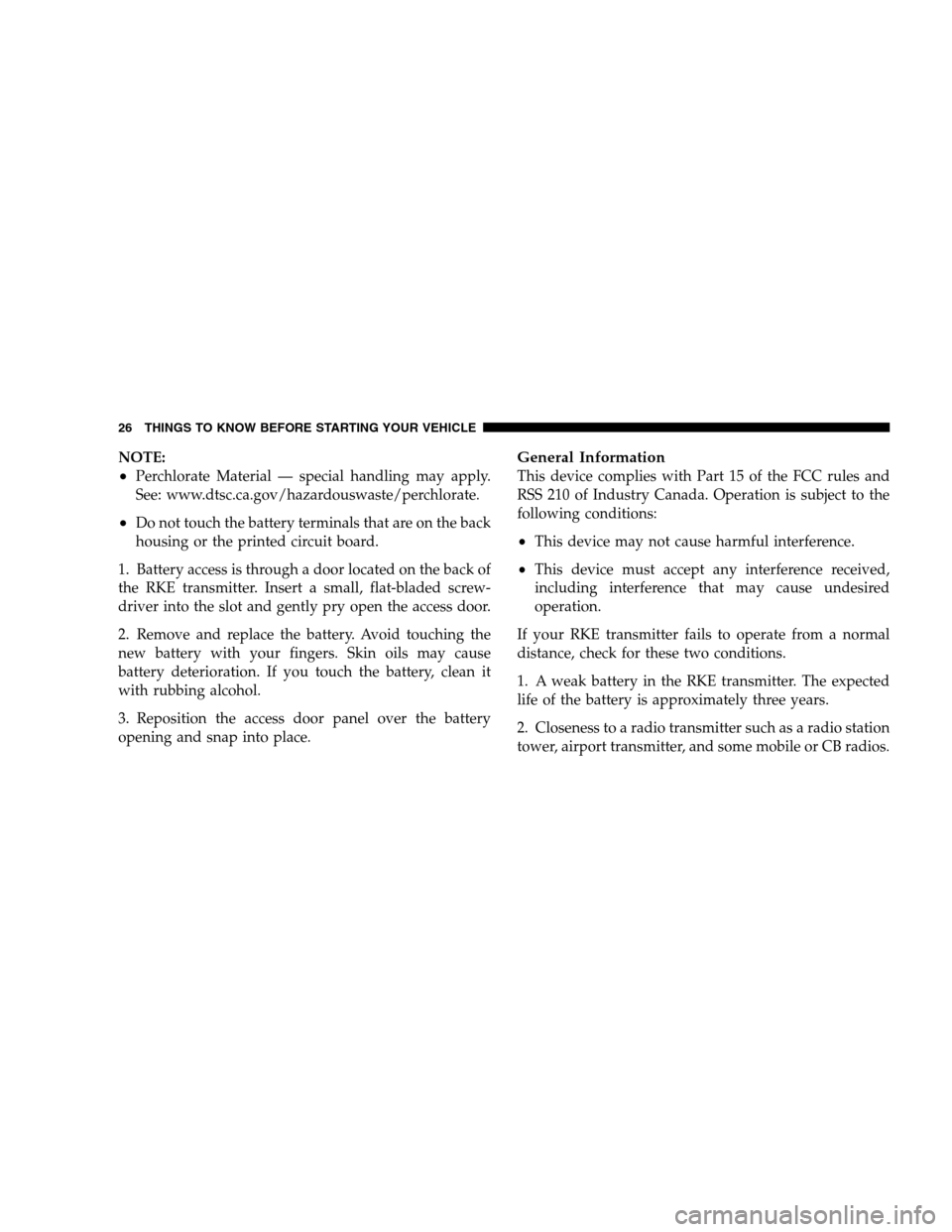
NOTE:
Perchlorate Material — special handling may apply.
See: www.dtsc.ca.gov/hazardouswaste/perchlorate.
Do not touch the battery terminals that are on the back
housing or the printed circuit board.
1. Battery access is through a door located on the back of
the RKE transmitter. Insert a small, flat-bladed screw-
driver into the slot and gently pry open the access door.
2. Remove and replace the battery. Avoid touching the
new battery with your fingers. Skin oils may cause
battery deterioration. If you touch the battery, clean it
with rubbing alcohol.
3. Reposition the access door panel over the battery
opening and snap into place.
General Information
This device complies with Part 15 of the FCC rules and
RSS 210 of Industry Canada. Operation is subject to the
following conditions:
This device may not cause harmful interference.
This device must accept any interference received,
including interference that may cause undesired
operation.
If your RKE transmitter fails to operate from a normal
distance, check for these two conditions.
1. A weak battery in the RKE transmitter. The expected
life of the battery is approximately three years.
2. Closeness to a radio transmitter such as a radio station
tower, airport transmitter, and some mobile or CB radios.
26 THINGS TO KNOW BEFORE STARTING YOUR VEHICLE
Page 47 of 535
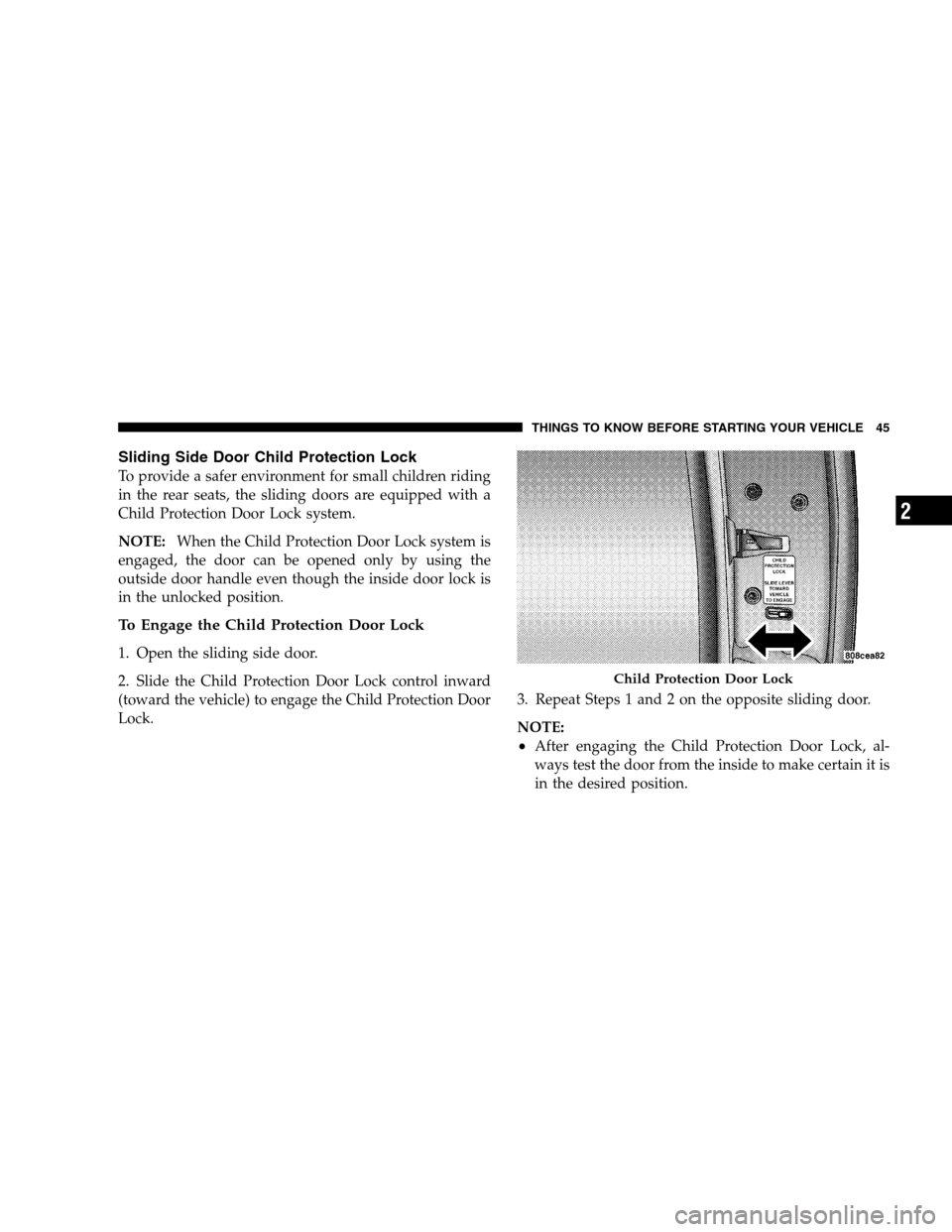
Sliding Side Door Child Protection LockTo provide a safer environment for small children riding
in the rear seats, the sliding doors are equipped with a
Child Protection Door Lock system.
NOTE:
When the Child Protection Door Lock system is
engaged, the door can be opened only by using the
outside door handle even though the inside door lock is
in the unlocked position.
To Engage the Child Protection Door Lock
1. Open the sliding side door.
2. Slide the Child Protection Door Lock control inward
(toward the vehicle) to engage the Child Protection Door
Lock. 3. Repeat Steps 1 and 2 on the opposite sliding door.
NOTE:
After engaging the Child Protection Door Lock, al-
ways test the door from the inside to make certain it is
in the desired position. Child Protection Door Lock
THINGS T
O KNOW BEFORE STARTING YOUR VEHICLE 45 2
Page 60 of 535
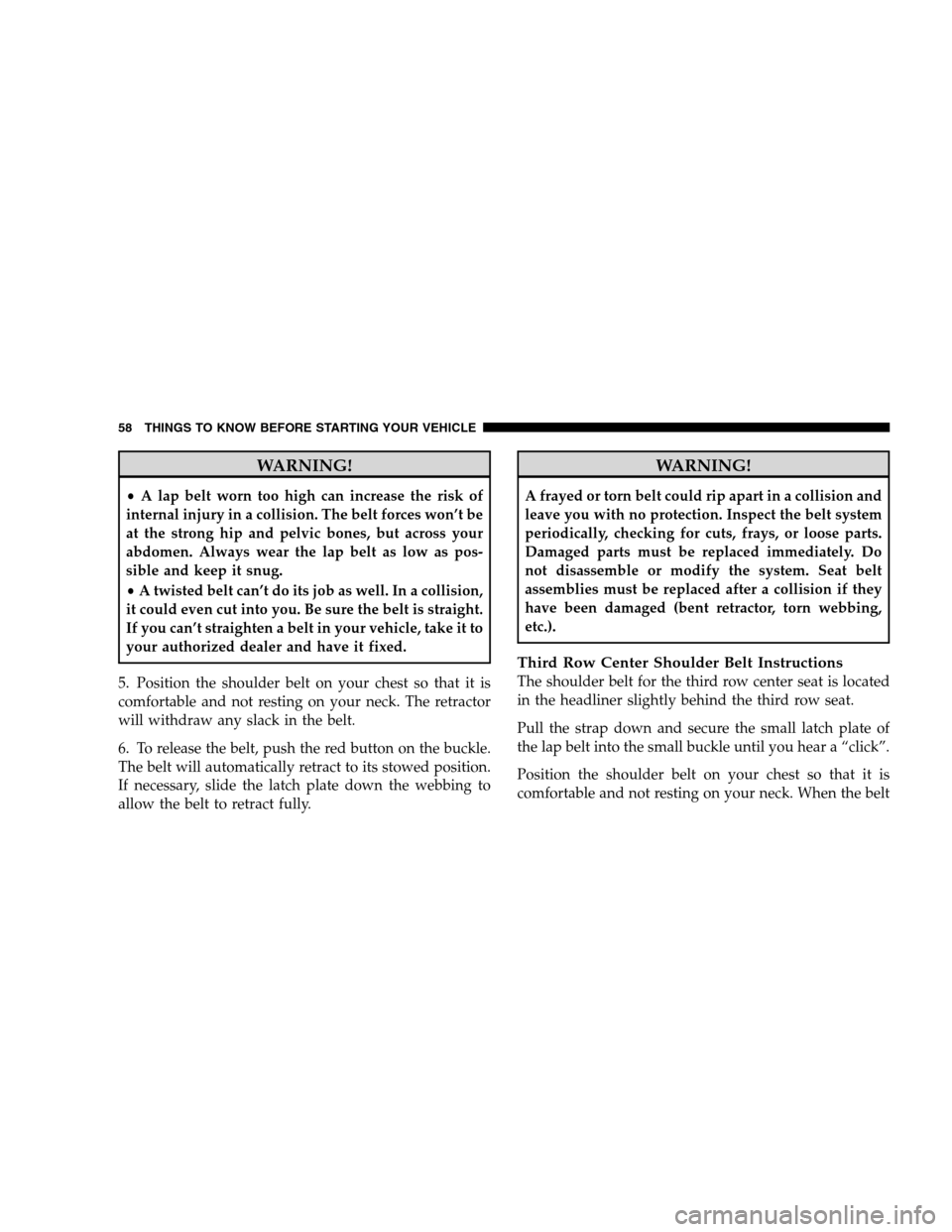
WARNING!
A lap belt worn too high can increase the risk of
internal injury in a collision. The belt forces won’t be
at the strong hip and pelvic bones, but across your
abdomen. Always wear the lap belt as low as pos-
sible and keep it snug.
A twisted belt can’t do its job as well. In a collision,
it could even cut into you. Be sure the belt is straight.
If you can’t straighten a belt in your vehicle, take it to
your authorized dealer and have it fixed.
5. Position the shoulder belt on your chest so that it is
comfortable and not resting on your neck. The retractor
will withdraw any slack in the belt.
6. To release the belt, push the red button on the buckle.
The belt will automatically retract to its stowed position.
If necessary, slide the latch plate down the webbing to
allow the belt to retract fully. WARNING!A frayed or torn belt could rip apart in a collision and
leave you with no protection. Inspect the belt system
periodically, checking for cuts, frays, or loose parts.
Damaged parts must be replaced immediately. Do
not disassemble or modify the system. Seat belt
assemblies must be replaced after a collision if they
have been damaged (bent retractor, torn webbing,
etc.).
Third Row Center Shoulder Belt Instructions
The shoulder belt for the third row center seat is located
in the headliner slightly behind the third row seat.
Pull the strap down and secure the small latch plate of
the lap belt into the small buckle until you hear a “click”.
Position the shoulder belt on your chest so that it is
comfortable and not resting on your neck. When the belt
58 THINGS TO KNOW BEFORE STARTING YOUR VEHICLE
Page 64 of 535
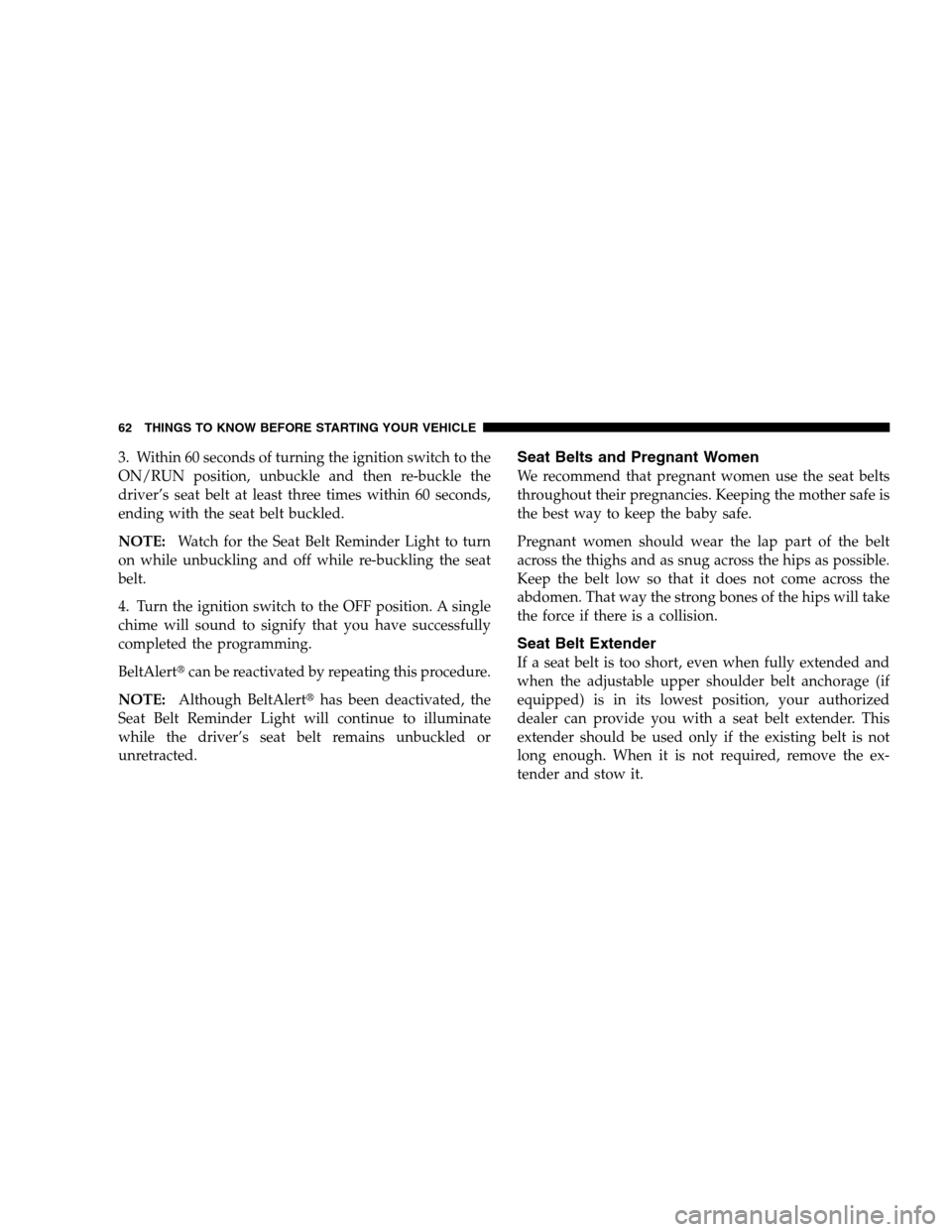
3. Within 60 seconds of turning the ignition switch to the
ON/RUN position, unbuckle and then re-buckle the
driver’s seat belt at least three times within 60 seconds,
ending with the seat belt buckled.
NOTE:Watch for the Seat Belt Reminder Light to turn
on while unbuckling and off while re-buckling the seat
belt.
4. Turn the ignition switch to the OFF position. A single
chime will sound to signify that you have successfully
completed the programming.
BeltAlertt can be reactivated by repeating this procedure.
NOTE: Although BeltAlertt has been deactivated, the
Seat Belt Reminder Light will continue to illuminate
while the driver’s seat belt remains unbuckled or
unretracted.Seat Belts and Pregnant Women
We recommend that pregnant women use the seat belts
throughout their pregnancies. Keeping the mother safe is
the best way to keep the baby safe.
Pregnant women should wear the lap part of the belt
across the thighs and as snug across the hips as possible.
Keep the belt low so that it does not come across the
abdomen. That way the strong bones of the hips will take
the force if there is a collision.
Seat Belt Extender
If a seat belt is too short, even when fully extended and
when the adjustable upper shoulder belt anchorage (if
equipped) is in its lowest position, your authorized
dealer can provide you with a seat belt extender. This
extender should be used only if the existing belt is not
long enough. When it is not required, remove the ex-
tender and stow it.
62 THINGS TO KNOW BEFORE STARTING YOUR VEHICLE
Page 87 of 535
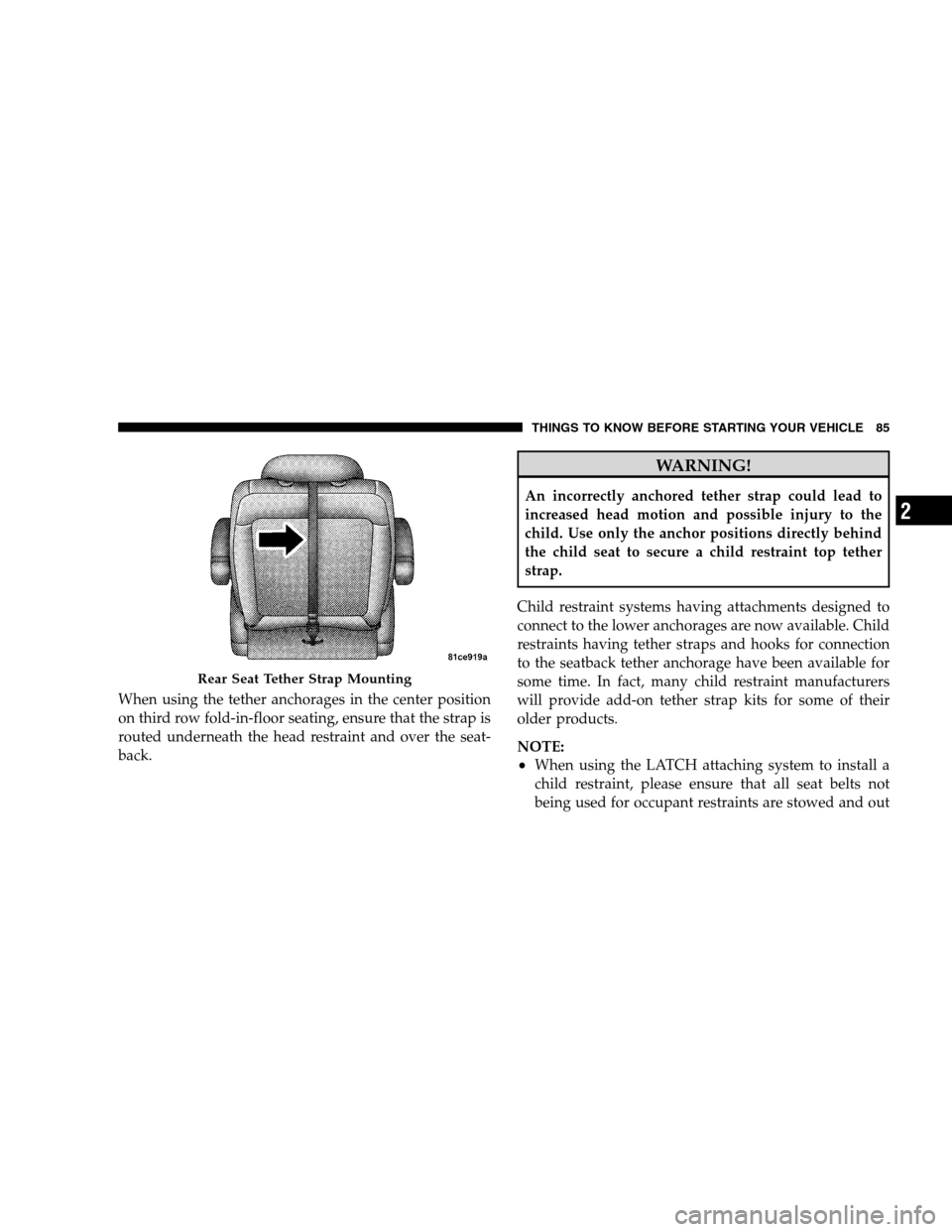
When using the tether anchorages in the center position
on third row fold-in-floor seating, ensure that the strap is
routed underneath the head restraint and over the seat-
back.WARNING!
An incorrectly anchored tether strap could lead to
increased head motion and possible injury to the
child. Use only the anchor positions directly behind
the child seat to secure a child restraint top tether
strap.
Child restraint systems having attachments designed to
connect to the lower anchorages are now available. Child
restraints having tether straps and hooks for connection
to the seatback tether anchorage have been available for
some time. In fact, many child restraint manufacturers
will provide add-on tether strap kits for some of their
older products.
NOTE:
When using the LATCH attaching system to install a
child restraint, please ensure that all seat belts not
being used for occupant restraints are stowed and out Rear Seat Tether Strap Mounting
THINGS T
O KNOW BEFORE STARTING YOUR VEHICLE 85 2
Page 88 of 535
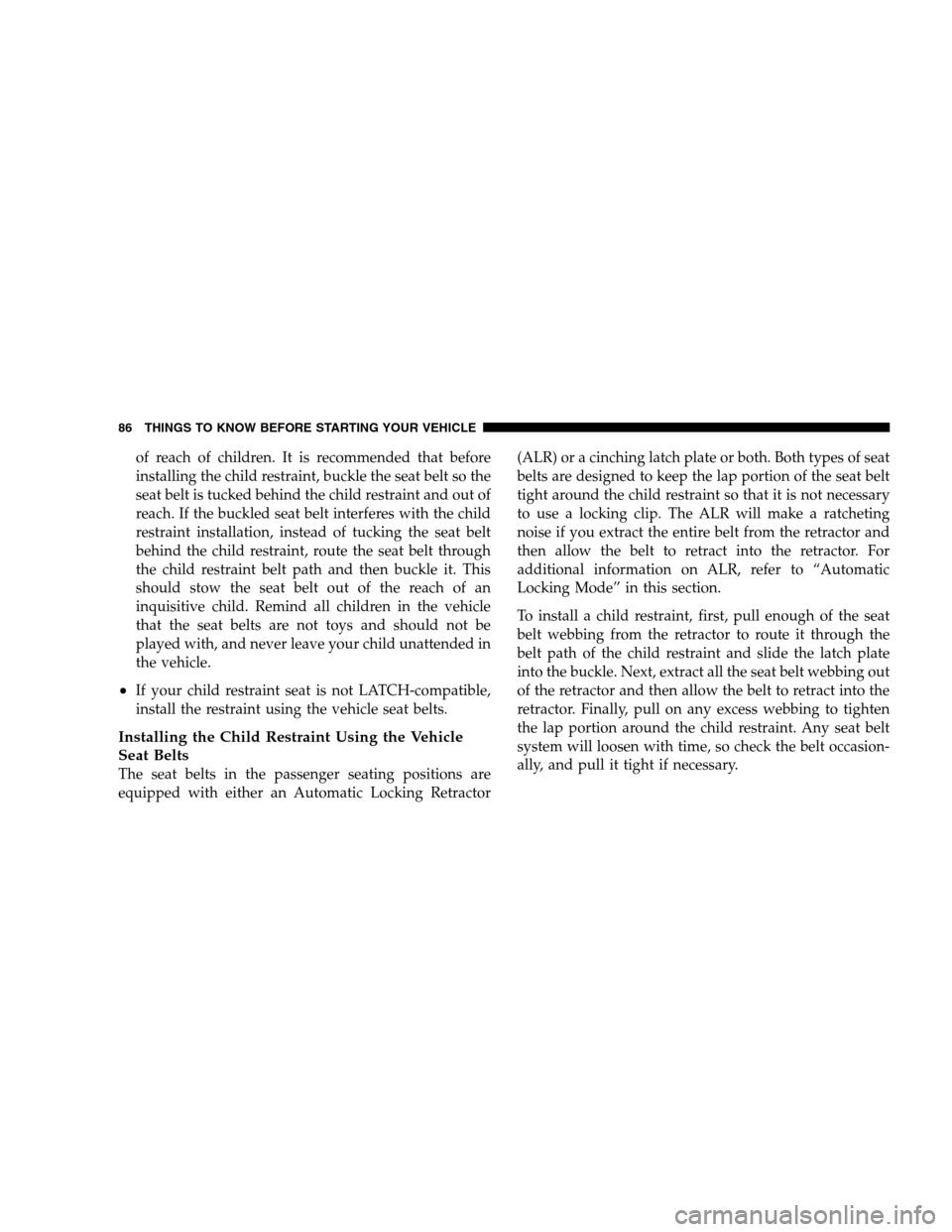
of reach of children. It is recommended that before
installing the child restraint, buckle the seat belt so the
seat belt is tucked behind the child restraint and out of
reach. If the buckled seat belt interferes with the child
restraint installation, instead of tucking the seat belt
behind the child restraint, route the seat belt through
the child restraint belt path and then buckle it. This
should stow the seat belt out of the reach of an
inquisitive child. Remind all children in the vehicle
that the seat belts are not toys and should not be
played with, and never leave your child unattended in
the vehicle.
If your child restraint seat is not LATCH-compatible,
install the restraint using the vehicle seat belts.
Installing the Child Restraint Using the Vehicle
Seat Belts
The seat belts in the passenger seating positions are
equipped with either an Automatic Locking Retractor(ALR) or a cinching latch plate or both. Both types of seat
belts are designed to keep the lap portion of the seat belt
tight around the child restraint so that it is not necessary
to use a locking clip. The ALR will make a ratcheting
noise if you extract the entire belt from the retractor and
then allow the belt to retract into the retractor. For
additional information on ALR, refer to “Automatic
Locking Mode” in this section.
To install a child restraint, first, pull enough of the seat
belt webbing from the retractor to route it through the
belt path of the child restraint and slide the latch plate
into the buckle. Next, extract all the seat belt webbing out
of the retractor and then allow the belt to retract into the
retractor. Finally, pull on any excess webbing to tighten
the lap portion around the child restraint. Any seat belt
system will loosen with time, so check the belt occasion-
ally, and pull it tight if necessary.
86 THINGS TO KNOW BEFORE STARTING YOUR VEHICLE
Page 98 of 535
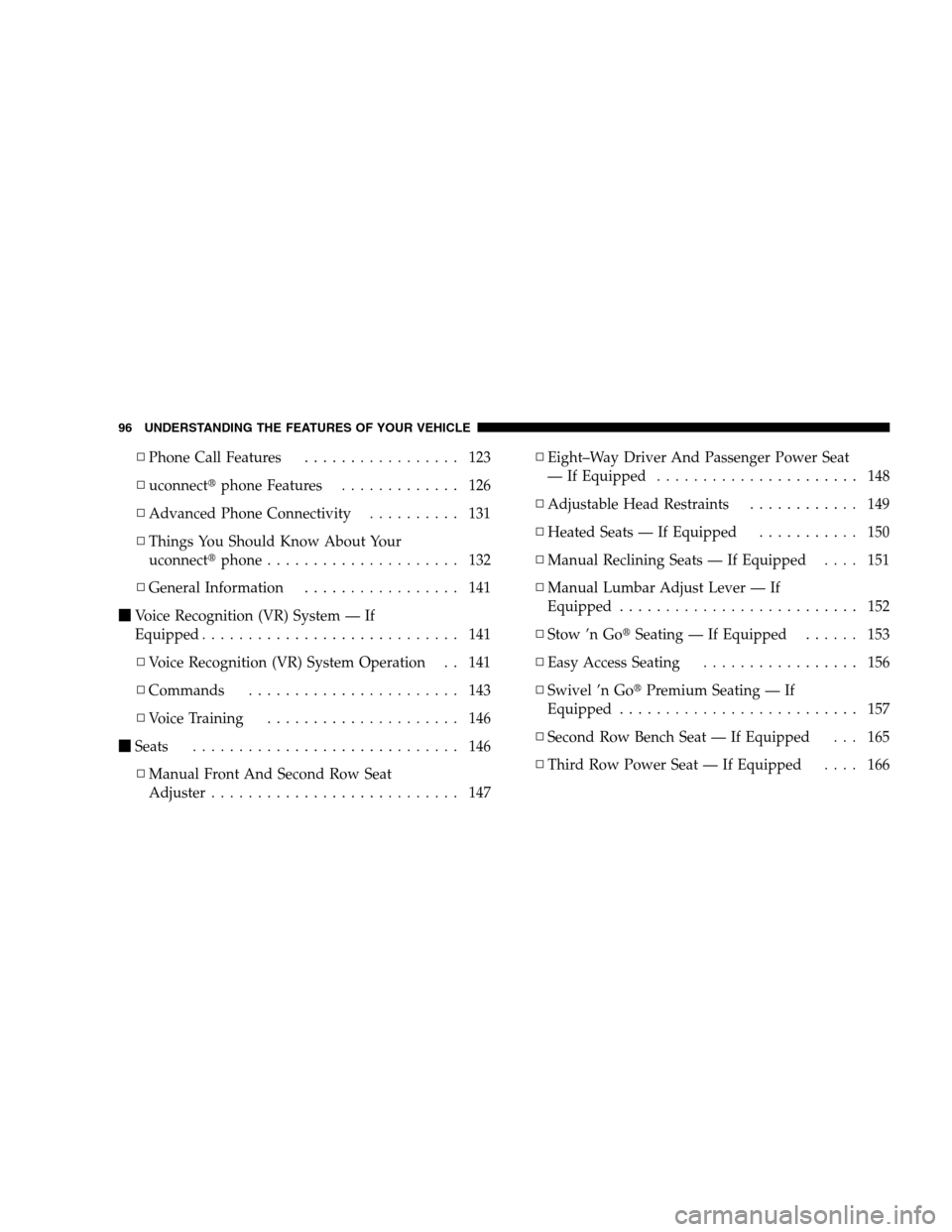
▫Phone Call Features . . . . . . . . . . . . . . . . . 123
▫ uconnectt phone Features . . . . . . . . . . . . . 126
▫ Advanced Phone Connectivity . . . . . . . . . . 131
▫ Things You Should Know About Your
uconnectt phone . . . . . . . . . . . . . . . . . . . . . 132
▫ General Information . . . . . . . . . . . . . . . . . 141
m Voice Recognition (VR) System — If
Equipped . . . . . . . . . . . . . . . . . . . . . . . . . . . . 141
▫ Voice Recognition (VR) System Operation . . 141
▫ Commands . . . . . . . . . . . . . . . . . . . . . . . 143
▫ Voice Training . . . . . . . . . . . . . . . . . . . . . 146
m Seats . . . . . . . . . . . . . . . . . . . . . . . . . . . . . 146
▫ Manual Front And Second Row Seat
Adjuster . . . . . . . . . . . . . . . . . . . . . . . . . . . 147 ▫
Eight–Way Driver And Passenger Power Seat
— If Equipped . . . . . . . . . . . . . . . . . . . . . . 148
▫ Adjustable Head Restraints . . . . . . . . . . . . 149
▫ Heated Seats — If Equipped . . . . . . . . . . . 150
▫ Manual Reclining Seats — If Equipped . . . . 151
▫ Manual Lumbar Adjust Lever — If
Equipped . . . . . . . . . . . . . . . . . . . . . . . . . . 152
▫ Stow ’n Got Seating — If Equipped . . . . . . 153
▫ Easy Access Seating . . . . . . . . . . . . . . . . . 156
▫ Swivel ’n Got Premium Seating — If
Equipped . . . . . . . . . . . . . . . . . . . . . . . . . . 157
▫ Second Row Bench Seat — If Equipped . . . 165
▫ Third Row Power Seat — If Equipped . . . . 166
96 UNDERSTANDING THE FEATURES OF YOUR VEHICLE
Page 102 of 535
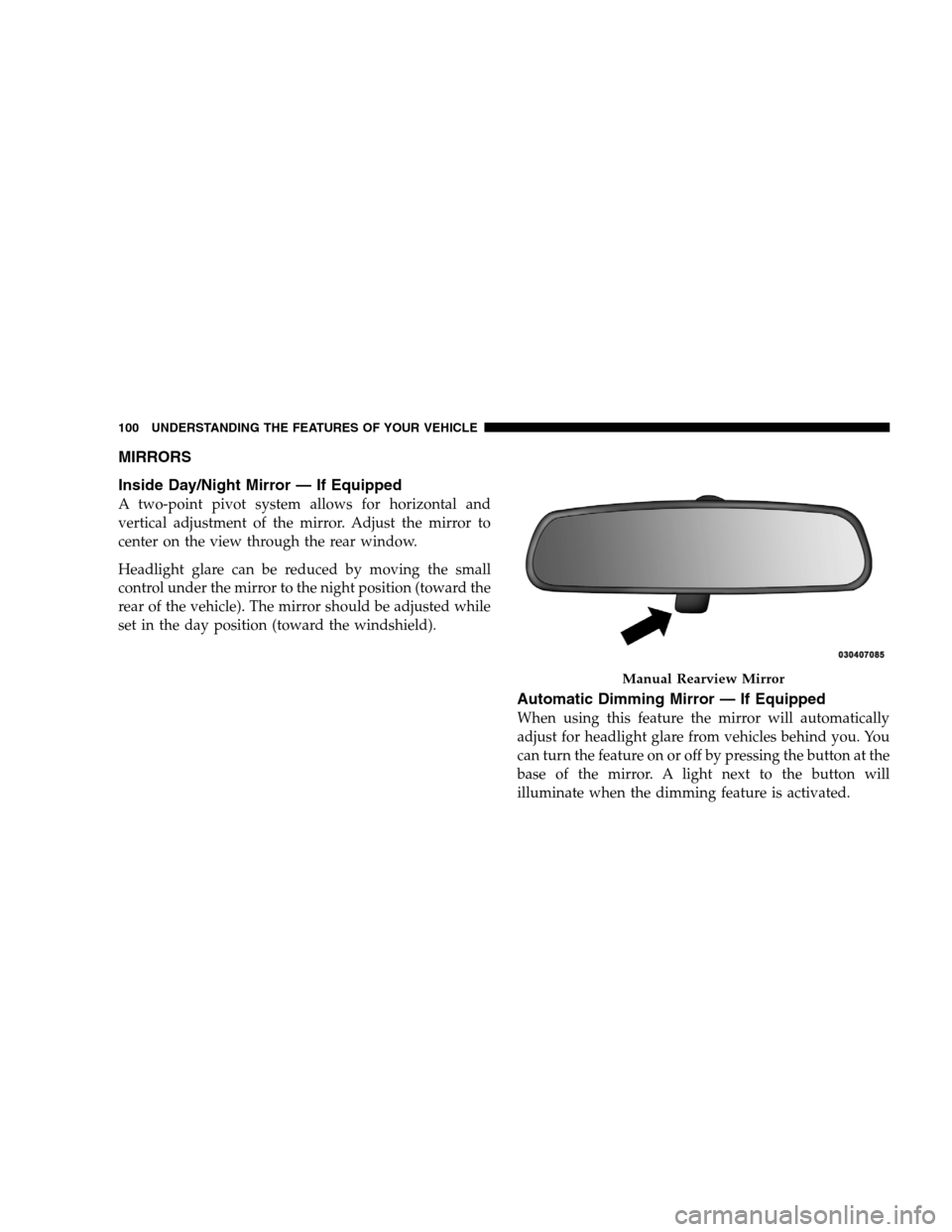
MIRRORS
Inside Day/Night
Mirror — If Equipped
A two-point pivot system allows for horizontal and
vertical adjustment of the mirror. Adjust the mirror to
center on the view through the rear window.
Headlight glare can be reduced by moving the small
control under the mirror to the night position (toward the
rear of the vehicle). The mirror should be adjusted while
set in the day position (toward the windshield).
Automatic Dimming Mirror — If Equipped
When using this feature the mirror will automatically
adjust for headlight glare from vehicles behind you. You
can turn the feature on or off by pressing the button at the
base of the mirror. A light next to the button will
illuminate when the dimming feature is activated. Manual Rearview Mirror
100 UNDERST
ANDING THE FEATURES OF YOUR VEHICLE
Page 107 of 535
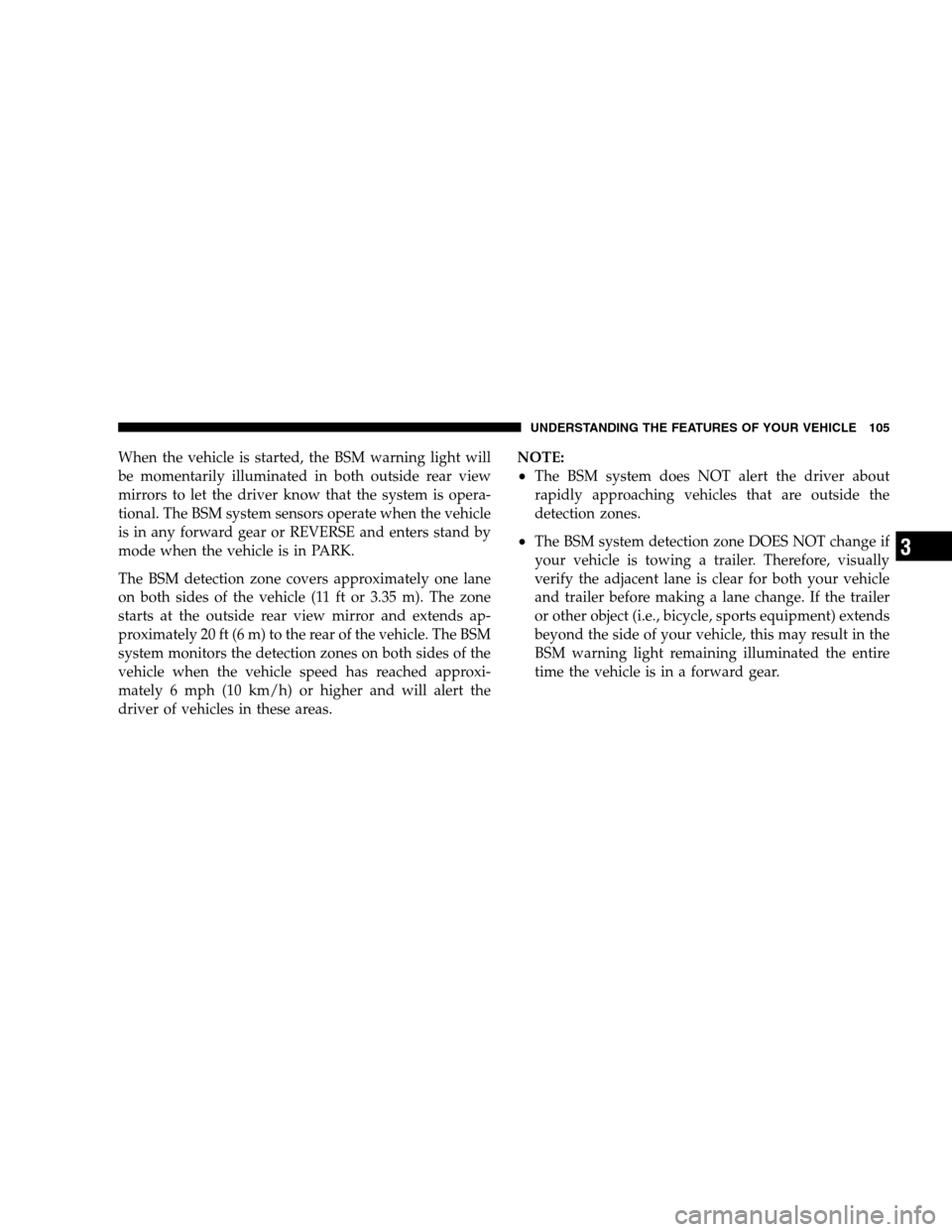
When the vehicle is started, the BSM warning light will
be momentarily illuminated in both outside rear view
mirrors to let the driver know that the system is opera-
tional. The BSM system sensors operate when the vehicle
is in any forward gear or REVERSE and enters stand by
mode when the vehicle is in PARK.
The BSM detection zone covers approximately one lane
on both sides of the vehicle (11 ft or 3.35 m). The zone
starts at the outside rear view mirror and extends ap-
proximately 20 ft (6 m) to the rear of the vehicle. The BSM
system monitors the detection zones on both sides of the
vehicle when the vehicle speed has reached approxi-
mately 6 mph (10 km/h) or higher and will alert the
driver of vehicles in these areas.NOTE:
The BSM system does NOT alert the driver about
rapidly approaching vehicles that are outside the
detection zones.
The BSM system detection zone DOES NOT change if
your vehicle is towing a trailer. Therefore, visually
verify the adjacent lane is clear for both your vehicle
and trailer before making a lane change. If the trailer
or other object (i.e., bicycle, sports equipment) extends
beyond the side of your vehicle, this may result in the
BSM warning light remaining illuminated the entire
time the vehicle is in a forward gear.
UNDERSTANDING THE FEATURES OF YOUR VEHICLE 105 3
Page 113 of 535
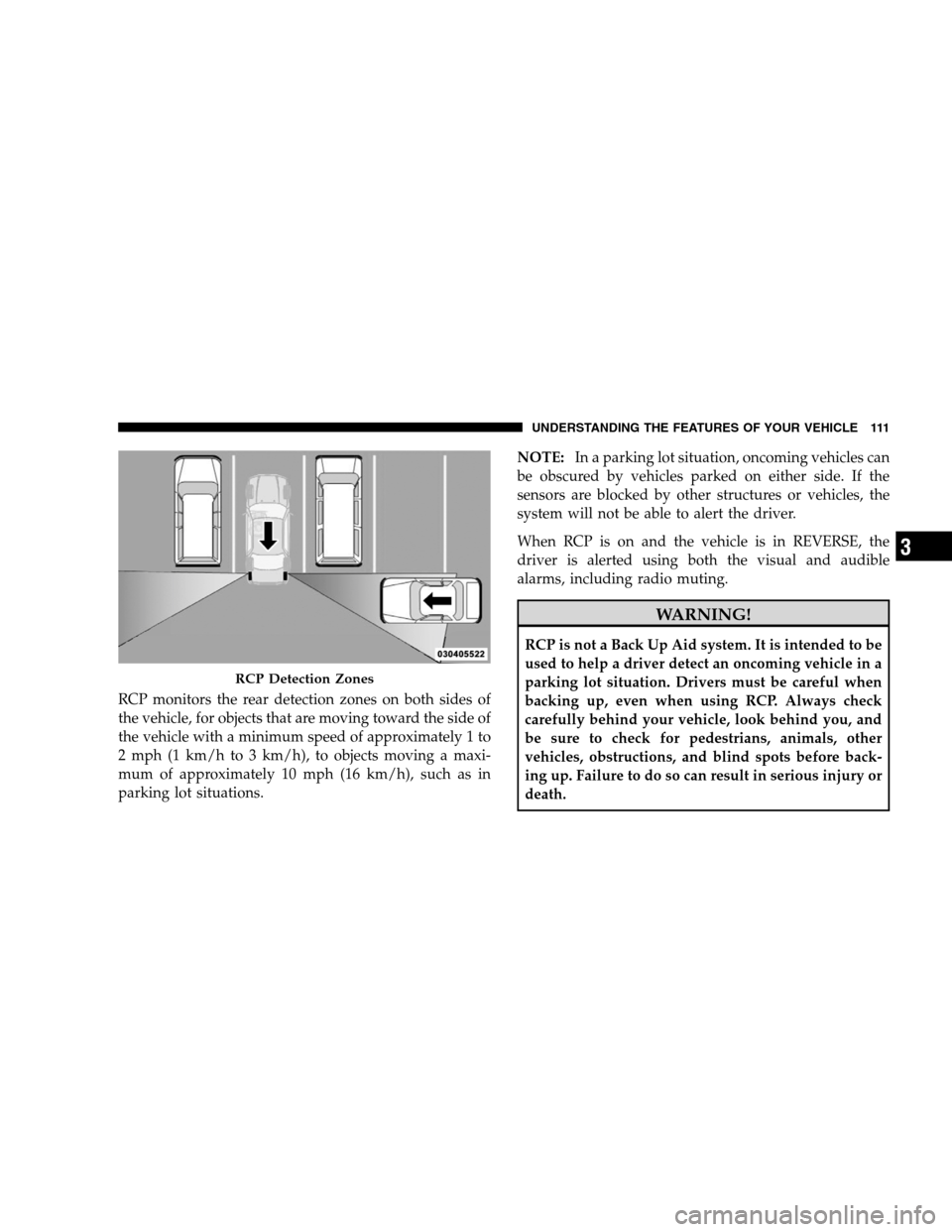
RCP monitors the rear detection zones on both sides of
the vehicle, for objects that are moving toward the side of
the vehicle with a minimum speed of approximately 1 to
2 mph (1 km/h to 3 km/h), to objects moving a maxi-
mum of approximately 10 mph (16 km/h), such as in
parking lot situations.NOTE:
In a parking lot situation, oncoming vehicles can
be obscured by vehicles parked on either side. If the
sensors are blocked by other structures or vehicles, the
system will not be able to alert the driver.
When RCP is on and the vehicle is in REVERSE, the
driver is alerted using both the visual and audible
alarms, including radio muting. WARNING!
RCP is not a Back Up Aid system. It is intended to be
used to help a driver detect an oncoming vehicle in a
parking lot situation. Drivers must be careful when
backing up, even when using RCP. Always check
carefully behind your vehicle, look behind you, and
be sure to check for pedestrians, animals, other
vehicles, obstructions, and blind spots before back-
ing up. Failure to do so can result in serious injury or
death.
RCP Detection Zones
UNDERSTANDING
THE FEATURES OF YOUR VEHICLE 111 3